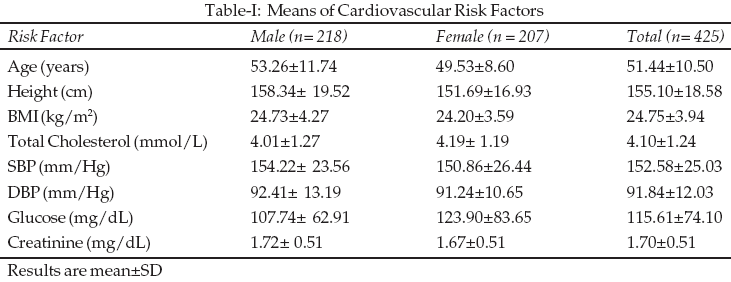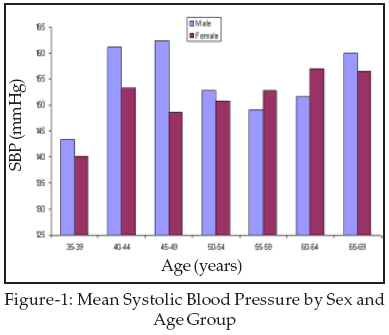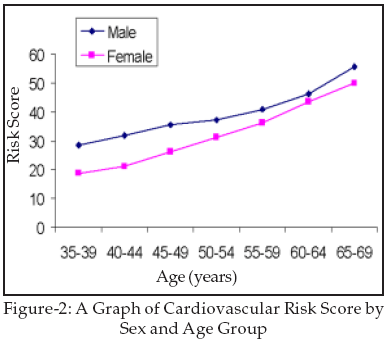|
|
||||
|
Published by : PROFESSIONAL MEDICAL PUBLICATIONS |
||||
|
ISSN 1681-715X |
||||
|
||||
|
- |
||||
|
ORIGINAL ARTICLE |
||||
|
- |
||||
|
Volume 24 |
April - June 2008 (Part-II) |
Number 3 |
||
|
|
||||
|
|
||||
|
|
||||
|
Published by : PROFESSIONAL MEDICAL PUBLICATIONS |
||||
|
ISSN 1681-715X |
||||
|
||||
|
- |
||||
|
ORIGINAL ARTICLE |
||||
|
- |
||||
|
Volume 24 |
April - June 2008 (Part-II) |
Number 3 |
||
|
|
||||
|
|
||||
Assessment of cardiovascular disease risk factors
of an urban Nigerian hypertensive population
using a risk score calculator
Ezeanyika LUS1, Ugwu CE2, Nwanguma BC3,
Onah LE4, Ojobo C5, Abba V6, Okpanachi G7
ABSTRACT
Objective: A cardiovascular risk score calculator was used to assess the risk of death from cardiovascular disease in an urban population with high blood pressure.
Methodology: A total of 425 subjects aged 35 years and above took part in the cross sectional survey held at Nsukka, Enugu State, Nigeria. A detailed questionnaire was administered to the subjects to ascertain their risk levels consequent upon life style and genetic disposition. Anthropometric parameters and blood pressures (SBP) and diastolic blood pressure (DBP) were measured by standard methods. Fasting blood samples were drawn from the participants for biochemical assays. A cardiovascular risk calculator was used to determine the risk of the subjects to cardiovascular disease (CVD).
Results: The mean ages were 53.26±11.76 and 49.53±8.6 years for men and women respectively, while the mean SBP were 154.22±23.56 and 150.86±26.44mm/Hg. The distribution of the subjects according to risk status were 21.88% for both low and very high risk status while 31.29% were of average risk. The cardiovascular risk score was higher (P < 0.05) in men than in the women.
Conclusion: Overall, the predicted risk of death from cardiovascular causes progressed with age in both genders. The results also show that men were more likely to die of cardiovascular diseases.
KEY WORDS: Hypertension, Risk factors, Risk score calculator, Cardiovascular diseases.
Pak J Med Sci April - June 2008 (Part-II) Vol. 24 No. 3 390-394
How to cite this article:
Ezeanyika LUS, Ugwu CE, Nwangwuma BC, Onah LE, Ojobo C, Abba V, et al. Assessment of cardiovascular disease risk factors of an urban Nigerian hypertensive population using a risk score calculator. Pak J Med Sci 2008;24(3):390-4.
1. Ezeanyika LUS,
2. Ugwu CE,
3. Nwanguma BC,
4. Onah LE ,
5. Ojobo C,
1-5: Department of Biochemistry,
University of Nigeria, Nsukka - Nigeria.
6. Abba V,
7. Okpanachi G,
6,7: Department of Biochemistry,
Kogi State University, Anyigba - Nigeria.
Correspondence:
Ugwu CE,
E-mail: ugwuchidiksu@yahoo.com
* Received for Publication: January 5, 2008
* Accepted: May 3, 2008
INTRODUCTION
Cardiovascular disease (CVD) is responsible for one third of global deaths and is the leading and increasing contributor to the global disease burden.
1 Africa has witnessed increased urbanization and changing lifestyles, factors which have, in turn, raised the incidence of CVD.2 Hypertension remains the most threatening risk factor, with prevalence ranging between 15% and 30% in adults3 although the mortality rate is higher in developing countries than in developed ones.4 Studies from South Africa have shown that 32.1% of men and 18.9% of women over 30 years had a 20% or higher risk of developing CVD in the next ten years5. There are often multiple risk factors. The prevalence of hypertension in many developing countries is as high as those seen in developed countries.6,7The risk score
8,9 calculates the risk of death from CVD in the next five years of individuals with high blood pressure. The calculator gives the result of the patient’s risk score and predicts the risk of death due to cardiovascular disease by comparing the values to an average value for a person of the same sex and similar age range.Other scoring methods already exist for assessing risks,
10,11,13,14 but the risk score used in this study has several particularly useful features. It focuses on patients with high blood pressure (HBP) and assesses an individual’s overall risk for all CVDs, including stroke, rather than just coronary heart disease.9Sequel to the apparent increase in the number of people suffering from hypertension, there is an urgent need to assess the risk of death from CVD in an urban Nigerian population. This is the objective of this study.
METHODOLOGY
This work studied 425 subjects (218 males and 207 females) aged 35 years and above, who were residents of the University town of Nsukka, South Eastern Nigeria. This is the age when the subjects may likely have any risk of CVD. Subjects with systolic blood pressure (SBP) less than 120 mm/Hg were excluded in the study. To encourage consent and allay the anxiety of the participants, the aim of the study was explained to them. The study was conducted in three parts; (a) collection of data on demographic and socioeconomic status (sex, age, family status, educational level) and health behaviours (physical activity at work and during leisure time, smoking, alcohol intake, and diet; (b) anthropometric (height, weight) and blood pressure measurements; and (c) blood sample tests. Information on the following cardiovascular risk factors: smoking, left ventricular hypertrophy, histories of stroke and of myocardial infarction were obtained from the subjects. Smoking status was divided into three categories (a) never smokers (b) former smokers; and current smokers (defined as people smoking at least one stick of cigarette each day). Anthropometric measurements used standardized procedures15. Height was measured to the nearest centimetre using a measuring tape. Weight was recorded with a mechanical personal scale (BR 9011, Hana, China) calibrated at the beginning of each working day to the nearest 0.1kg. Body mass index (BMI) was calculated as weight (in kg) divided by height (in metre squared). Blood pressure (BP) was measured twice using a digital BP meter (Seiwex SE-7000 Seinex electronic Ltd, UK) with the subject seated for at least five minutes, and using left arm.16High blood pressure was defined according to the WHO/ISH guideline: a systolic blood pressure (SBP) >140mm/Hg or diastolic blood pressure (DBP) >90mm/Hg or being on treatment.
17 Stage I (mild hypertension) was defined as a SBP between 140-150 or DBP between 90-99mm/Hg. Stage II (moderate hypertension) as a SBP between 160-176mm/Hg or DBP between 90-99 mm/Hg. Stage III (severe hypertension) as a SBP >180 or DBP >110mm/Hg. Blood samples were collected from the subjects and analyzed within two hours. Serum glucose was estimated with a glucometer (Life Scan Inc, Johnson-Johnson Company, USA) by the one-touch blood glucose monitoring system18 and presence of diabetes was defined using WHO recommendations.19 Total cholesterol was estimated on enzymatic hydrolysis and oxidation of cholesterol by the method of Stein,20 while serum creatinine was estimated by the method of Henry.21 Hypercholesterolaemia was defined as total cholesterol (TC) >5.17mmol/L. Randox Laboratories Ltd., UK, commercially prepared the reagents used. A BMI >25kg/m2 was defined as overweight.22 The data collected from the eleven risk factors were keyed into the risk score calculator, which provides the risk score, and the predicted risk score by comparing with an average score that is age and sex specific.8 The risk score is an integer; with points added for each factor according to its association with the risk. For any subject, points scored for each factor were added together to produce the total risk score.9The statistical analysis was done using SPSS version 10.0. Data collected were subjected to analysis of variance (ANOVA) using factorial in completely randomized design (CRD). The mean ± SD of each parameter was taken for each group. Test of significance of mean was by Fisher’s least significance difference (F-LSD). The acceptable level of significance was P <0.05.
RESULTS
Table-I shows the mean values of the cardiovascular risk factors in the sampled population. The mean SBP prevalence was higher in men than in the women, going up to peak between 45-49 years ini men and 60-64 years in women (Fig-1).


Table-II shows the frequency and risk status in the different genders. Ninety-three participants (21.88%) were grouped as low risk while 133 participants (31.29%) were averagely at risk to CVDs. Of the 106 participants that were on the high risk group, 17.89 and 32.37 percent were males and females respectively.

Fig-2 shows the cardiovascular risk score of the subjects. The result shows that the risk score increased progressively as the age increased with the men having a significantly higher (P < 0.05) risk score than the women. The predicted risk score (%) of the subjects (Table-III); show that the chances of death from CV sources in the next five years increased with age.

DISCUSSION
This study provides information on the risk of death from cardiovascular causes in the next five years of individuals with high blood pressure in the surveyed population. The cardiovascular risk score used in this study takes into account systolic but not diastolic blood pressure because diastolic blood pressure does not independently predict cardiovascular risk.23,24 The results from this study show a prevalence of high blood pressure in the population studied with the age group 45-49 having the highest value in men. This is consistent with previous results demonstrating gender dichotomy in blood pressure, with higher pressures seen in men.25-27

Cardiovascular risk score values also increased with age with the males having a higher risk score than the females. These scores were higher than the average risk score values for men and women of similar age ranges. The study also predicted the risk of dying from cardiovascular disease in five years of the sampled population and compared it to risk values for men and women of similar age range. Data from this study consistently showed that men had a higher risk of dying from cardiovascular causes than women. For the age range 65-69 years the risk scores were 8.59% and 13.97% respectively for men and women. Cardiovascular risk increases with age in both sexes, and this increase is sharper in women.28 The mechanism underlying this differential age effect is not well understood.29
The study stratified the participants into four risk status of low, average, high and very high risk category
30 with 21.88, 31.29, 24.94 and 21.88% respectively. The fact that above 46.82% of the participants was of above average risk calls for concern. Mortality from CVD varies between countries which affect the generalisation of any risk score internationally.31 The risk score from this study emphasizes the importance of tackling the overall risk of CVD in several ways rather than monitoring blood pressure alone.32-35 Studies of this nature when made available to individuals enable them to know the status of their hearts. This will in turn compel them to change habits or life styles that predispose to cardiovascular disorder and improve quality of life.REFERENCES
1. World Health Organization. The World Health Report 2002: Risk to health 2002. Geneva.
2. Kadiri S. Tackling cardiovascular disease in Africa. BMJ 2005;331:711-12.
3. Cooper RS, Rotimi CN, Kaufman JS, Mauna WFT, Mensah GA. Hypertension treatment and control in sub-saharan Africa: The epidemiologic basis for policy. BMJ 1998;16:614-17.
4. Reddy KS, Yusuf S. Emerging epidemic of cardiovascular disease in developing countries. Circulation 1998;97:596-601.
5. Alberts M, Urdal P, Steyn K, Stensvold I, Tverdal A, Nel JH, et al. Prevalence of cardiovascular disease and associated risk factors in a rural black population of South Africa. Eur J Cariovasc Prev Rehabil 2005;12:347-54.
6. Khor GL. Cardiovascular epidemiology in the Asia Pacific Region. Asia Pac J C Nutr 2001;10:76-80.
7. Vorster HH. The emergence of cardiovascular disease during urbanization of Africa. Public Health Nutr 2002;5:239-43.
8. Benneth M. (1998). www.riskscore.org.Uk March 20, 2007.
9. Pocock SJ, McCormack V, Gueyffier F, Boutitie F, Fagard R, Boisel J. A score for predicting risk of death from cardiovascular disease in adults with raised blood pressure based on individual patients data from randomized controlled trials. BMJ 2001;323:75-81.
10. Shaper AG, Pocock SJ, Walker M. Identifying men at high risk of heart attacks: Strategy for use in general practice. BMJ 1987;293:474-9.
11. Anderson KM, Odell PM, Willson PW, Kannel WB. Cardiovascular disease risk factors. Am Heart J 1991;121:293-8.
12. Coppola WGT, Whincup PH, Papacosta O, Walker M, Ebraham S. Scoring system to identify men at high risk of stroke; a strategy for general practice. Br J Gen Practice 1995;45:185-9.
13. Menotti A, Keys A, Blackburn H, Kromhout D, Karvonen M, Wissinen A. Comparison of multivariate prediction power of major risk factor of coronary heart disease in different countries: results from eight nations of the seven countries study, 25 years follow-up. J Cardiovascular Risk 1995;3:69-75.
14. D’Agostino RB, Russell MW, House DM, Ellison RC, Silbershartz H, Wilson PWE. Primary and subsequent coronary risk appraisal: New results from Framingham study. Am Heart J 2000;139:272-82.
15. World Health Organization. WHO Expert Committee on Diabetes Mellitus. Second Report (Tech. Report Series no 626). Geneva 1980.
16. Atman SL, Cooper RS, Rotimi CN, McGee D, Osotimehin B, Kadiri S, et al. Standardization of blood pressure measurements in an international comparative study. J Clin Epidemiol 1996;49:869-77.
17. World Health Organization (WHO) International Society of Hypertension (ISH). Statement on management of Hypertension. J Hypertension 2003;21:1983-92.
18. Mark SV, Dawson A. Rapid stick methods for determining of blood glucose concentration. BMJ 1965;1:293.
19. World Health, Guideline subcommittee (1999a). International Society of Hypertension guideline for the management of hypertension. J Hypertension (ISH). Statement on management of hypertension. J Hypertension 2003;21:1983-92.
20. Stein EA. Lipids, liporoteins and Apoliproteins. In: Text book of Clinical Chemistry. Tietz, N.W. (Ed) W.B. Saunder, Philadelphia 1986;826-900.
21. Henry RJ. Determination of Creatinine. In: Clinical Chemistry, Principles and Techniques. Hargerstein, M.D. (Ed). Harper and Row 1974;535.
22. Olusi SO. Obesity is an independent risk factor for plasma lipid per oxidation and depletion of erythrocyte cytoprotectic enzyme in humans. Int J Obesity 2002;26:(9)1159-64.
23. Kannel WB. Historic perspectives on the relative contributions of diastolic/systolic blood pressure elevation to cardiovascular risk profile. Am Heart J 1999;138:205-10.
24. Kannel WB. Historic perspectives on the relative contributions of diastolic/systolic blood pressure elevation to cardiovascular risk profile. Am Heart J 1999;138:205-10.
25. Shaper AG, Philips AN, Pococks SJ, Walker M, Macfarlane PW. Risk factors for stroke in middle aged British Men. BJM 1991;302:1111-15.
26. Shapo L, Pomerleau J, Mckee M. Epidemiology of hypertension and associated cardiovascular risk factors in a country in transition: A population based survey in Tirana city, Albania. J Epidemiol Community Health 2003;57:734-9.
27. Mufunda J. Body mass index and blood pressure: where are we now? J Human Hypertension 2007;21:5-7.
28. Tesfaye F, Nawi NG, Van Minh H, Byass P, Berhance Y, Binita R. Association between body mass index and blood pressure across three countries in Africa and Asia. J Hum Hypertension 2007;21(1):28-37.
29. Mosca L, Manson JE, Suterland SE, Langer RD, Menolio T, Barreett-connor E. Cardiovascular disease in women: a statement of health care professional from the American Heart Association. Circulation 1997;96:2468-82.
30. World Health Organization. Part 1: Diagnosis and Classification of Diabetes mellitus, Report of WHO consultation. Geneva: WHO 1999.
31. World Health Organization. World Health statistics annual 1998. Geneva.
32. Kannel WB, Castelli WP, McNamara PM, Mckee PA, Fenelb M. Role of blood pressure in the development of congestive heart failure: the Famingham Heart Study. N Engl J Med 1972;287(16):781-7.
33. Hjerman I, Velve Byre K, Holme I, Leren P. Effect of diet and smoking intervention on the incidence of coronary heart disease. Lancet II: 1981;1303-10.
34. Manson JE, Coldizt GA, Stamfer MF, Speizer FE, Hennekens CH, Willett WC, et al. A prospective study of obesity and risk of CHD in women. N Engl J Med 1990;332:882-9.
35. Savage PJ. Treatment of Diabetes Mellitus to reduce its chronic cardiovascular complications. Curr Opin Cardiol 1998;13:131-8.
HOME | SEARCH | CURRENT ISSUE | PAST ISSUES
Professional
Medical Publications
Room No. 522, 5th Floor, Panorama Centre
Building No. 2, P.O. Box 8766, Saddar, Karachi - Pakistan.
Phones : 5688791, 5689285 Fax : 5689860
pjms@pjms.com.pk